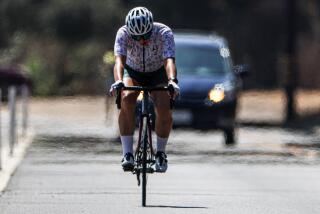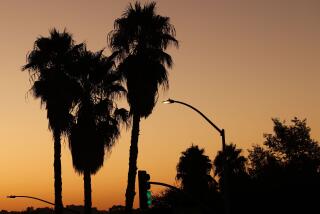Power nearly restored in L.A. after fierce winds, with more on the way

- Share via
Crews with the Los Angeles Department of Water and Power continued working Tuesday to restore electric service to customers who lost power amid strong winds a day earlier.
More than 24,000 customers who lost power as fierce winds buffeted the area Monday have had service restored. As of 10 a.m., the utility estimated that fewer than 200 customers were without power and that all the lights would be back on by noon.
The area, however, could see further outages as the week progresses and northeasterly Santa Ana winds move into the region.
“We have a cold front that’s going through the region associated with an area of low pressure that’s diving into eastern California,” said David Sweet, a meteorologist with the National Weather Service in Oxnard. “It’s going to stay on the cool and windy side ... before things start to settle down as we head into a warming trend.”
Temperatures fell to teeth-chattering levels overnight, with widespread swaths of the Southland reporting near- or below-freezing conditions.
The mercury reached a bone-chilling 10 degrees in Big Pines and plummeted to 14 degrees in parts of the Antelope Valley.
Lower-lying areas weren’t spared the nighttime chill. Some parts of the San Gabriel Valley and coastal Los Angeles County threatened the freezing mark, and temperatures dipped below 30 degrees in portions of Ventura County and the Santa Ynez Valley.
“As a result of a very cold air mass, two preliminary record-low temps were set this morning,” meteorologists said — at Paso Robles Municipal Airport, which hit 21 degrees, and at Santa Barbara Airport, which tied its record of 32 degrees.
Strong northeast winds of 20 to 30 mph with gusts up to 45 mph are expected for much of the San Fernando Valley, including Thousand Oaks, Simi Valley, Moorpark, Newbury Park, Woodland Hills, Northridge, Burbank and Universal City through Tuesday. Higher elevations could see gusts up to 55 mph, forecasters say.
The weather service issued a wind advisory for the region, warning of gusts that could uproot trees, turn unsecured objects into projectiles and make driving difficult, especially for high-profile vehicles.
In downtown L.A. on Monday, winds topped out at 50 mph. Elsewhere, gusts reached 57 mph in Saugus, 53 mph at Van Nuys Airport, 55 mph in Santa Monica, 47 mph in Inglewood and 45 mph at Los Angeles International Airport and Catalina Island, according to weather service data.
The wind knocked over massive trees in the Hollywood Hills and Sierra Madre. In Granada Hills, footage from OnScene.TV showed a tree that had crashed onto a house. In Porter Ranch, winds toppled a large pine on the westbound 118 Freeway at Reseda Boulevard, blocking two lanes.
On Monday evening, a large sign fell onto a car parked outside an El Super grocery store in the Vermont Knolls area of South Los Angeles. At LAX, a cargo jet was damaged when it struck a trash bin that had been blown onto a runway.
The weather service issued a freeze warning Monday for much of the San Fernando Valley, and only a slight warm-up, with a low of 33 degrees, is expected for Wednesday.
In Los Angeles, daytime temperatures were expected to linger in the low 60s Tuesday before warming slightly. By the weekend, forecasters expect a high of 70 degrees across much of Los Angeles County.
The chilly temperatures come on the heels of what was a record-breaking warm weekend for Southern California, with highs soaring above 80 degrees in some areas.
A record high of 81 degrees was set at LAX on Saturday, surpassing the previous mark of 79 degrees for the day in 1954. In Long Beach, a temperature of 84 degrees Saturday bested the previous record of 83 degrees set on the same day in 1995.
The dramatic swing in temperatures can be uncomfortable and is a bit unusual for winter in Southern California, Sweet said.
“It can happen,” he said, “but it doesn’t happen very often.”
More to Read
Sign up for Essential California
The most important California stories and recommendations in your inbox every morning.
You may occasionally receive promotional content from the Los Angeles Times.















